The demand for nutritive sweeteners in Japan is expected to reach USD 1.7 billion by 2035, reflecting an absolute increase of USD 0.5 billion over the forecast period. The demand, valued at USD 1.2 billion in 2025, is expected to grow at a CAGR of 3.3%. This growth is primarily driven by the increasing preference for healthier sweetening alternatives in food and beverage products, as well as by consumer demand for products that feature lower-calorie, natural, and functional ingredients.
Nutritive sweeteners, including sugars like sucrose, glucose, and natural alternatives such as stevia, are essential ingredients in various food products, including beverages, dairy, snacks, and processed foods. As Japan’s population becomes more health-conscious, there is an increasing demand for products with reduced sugar content, driving the adoption of alternative sweeteners that offer the same sweetness without the associated calories. Consumer preferences for natural, clean-label ingredients continue to rise, contributing to the growing demand for alternative sweeteners that are perceived as healthier options.
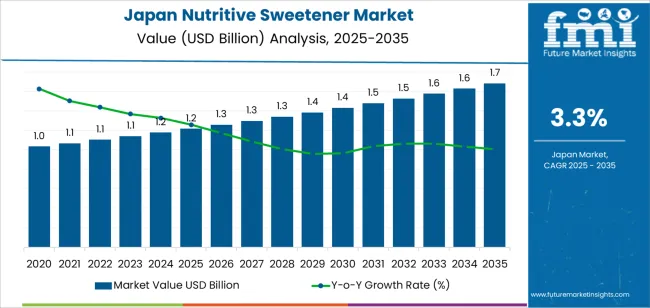
The food and beverage industry in Japan is increasingly adopting these sweeteners to meet the evolving consumer demand for healthier alternatives, creating substantial growth opportunities for the nutritive sweetener sector in the coming years.
The early growth curve for the demand for nutritive sweeteners in Japan between 2025 and 2030 shows a relatively moderate increase, with demand rising from USD 1.2 billion to USD 1.3 billion, adding USD 0.1 billion. This phase represents steady growth as consumers slowly shift towards healthier alternatives in response to growing awareness about the impact of sugar on health. During this period, the adoption of nutritive sweeteners will be gradual, driven by the increasing use of alternative sweeteners in health-conscious food products and beverages.
The late growth curve, from 2030 to 2035, shows a more substantial acceleration, with demand increasing from USD 1.3 billion to USD 1.7 billion, adding USD 0.4 billion. This acceleration reflects a stronger industry shift toward low-calorie, natural sweeteners, particularly as health trends continue to dominate consumer behavior. The late growth curve will be driven by greater availability of functional food and beverage products, innovations in sweetener formulations, and increasing consumer preference for products with clean, natural ingredients. The demand will also be fueled by the growing recognition of the health benefits of reducing sugar intake, further accelerating the adoption of nutritive sweeteners in the latter half of the forecast period.
| Metric | Value |
|---|---|
| Japan Nutritive Sweetener Value (2025) | USD 1.2 billion |
| Japan Nutritive Sweetener Forecast Value (2035) | USD 1.7 billion |
| Japan Nutritive Sweetener Forecast CAGR (2025 to 2035) | 3.3% |
The demand for nutritive sweeteners in Japan is growing due to the increasing consumer preference for healthier alternatives to traditional sugar, as well as the rising awareness of the importance of balanced nutrition. Nutritive sweeteners, such as fructose, glucose, and maltose, provide sweetness along with some caloric content, making them an attractive option for food and beverage manufacturers looking to create products that are both flavorful and lower in overall sugar content.
The growing trend of health-conscious consumers in Japan is a key factor driving the demand for nutritive sweeteners. With rising concerns over the health effects of excessive sugar consumption, such as obesity and diabetes, more consumers are seeking sweeteners that offer a healthier balance of sweetness and nutritional value. As Japan continues to emphasize the importance of maintaining a healthy diet and lifestyle, the demand for functional, nutritious ingredients like nutritive sweeteners is expected to rise.
The expanding industry for low-calorie and sugar-free food and beverage products is further fueling demand. Nutritive sweeteners are commonly used in the formulation of diet foods, beverages, and snacks, where they provide an alternative to sugar while maintaining taste. As the food industry in Japan continues to innovate in response to changing dietary preferences, the demand for nutritive sweeteners will likely continue to grow, especially in the functional foods and beverages sectors.
By product type, demand is divided into fructose, sucrose, corn sugar, honey, and high fructose corn syrup. Based on nature, demand is categorized into organic and conventional. By end use, demand is segmented into food processing, household/retail, bakery, confectionery, beverages, and pharmaceuticals. Regionally, demand is distributed across Kanto, Kinki, Chubu, Kyushu & Okinawa, Tohoku, and the Rest of Japan.
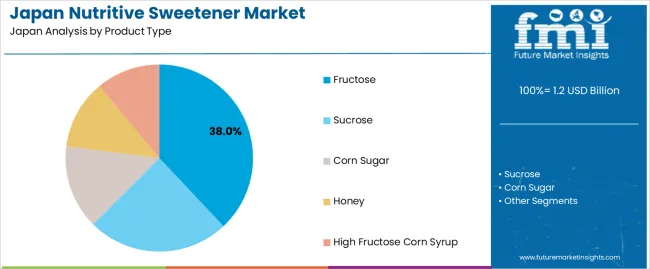
Fructose accounts for 38% of the demand for nutritive sweeteners in Japan. This high demand is primarily driven by fructose's ability to offer high sweetness with lower caloric content compared to sucrose, making it a popular choice for products targeting health-conscious consumers. Fructose, particularly in the form of high-fructose corn syrup (HFCS), is widely used in the food and beverage industries, especially in soft drinks, snacks, and processed foods. Fructose's ability to retain moisture and enhance flavor without significantly adding calories makes it an ideal sweetener for a wide range of applications. With Japan’s strong focus on reducing sugar intake and the demand for low-calorie products, fructose remains the preferred choice for manufacturers looking to cater to the growing industry of health-conscious consumers.
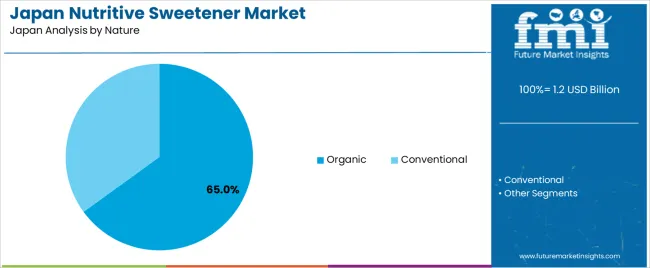
Organic sweeteners account for 65% of the demand in Japan, reflecting a growing preference for natural, clean-label products. Organic sweeteners are highly sought after for their perceived health benefits and environmentally friendly production methods. As Japanese consumers become increasingly health-conscious and concerned about the origins of their food, demand for organic alternatives to conventional sweeteners has surged. Organic sweeteners, such as organic fructose and honey, are free from synthetic additives and pesticides, making them highly attractive to health-conscious consumers and those who prioritize sustainable agricultural practices. The trend towards organic products, combined with Japan’s strong focus on quality and food safety, has positioned organic sweeteners as the dominant choice in the industry for nutritive sweeteners.
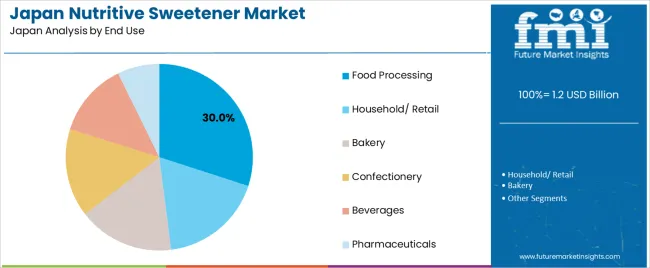
Food processing accounts for 30% of the demand for nutritive sweeteners in Japan. The food processing industry is the largest consumer of sweeteners, as they are essential for a wide range of products, including beverages, snacks, baked goods, and dairy items. Nutritive sweeteners like fructose and sucrose are key ingredients in enhancing the flavor, texture, and shelf life of processed food products. With Japan's increasing demand for processed, ready-to-eat, and convenience foods, food manufacturers rely heavily on sweeteners to meet consumer preferences for taste and quality. The growing trend of functional foods, which offer health benefits beyond basic nutrition, has led to the increased use of sweeteners in products aimed at providing energy, supporting immune function, or managing weight. As the food processing sector continues to expand, it remains the leading end-use sector for nutritive sweeteners in Japan.

Store-based retailing accounts for 45% of the demand for nutritive sweeteners in Japan. This distribution channel dominates due to the accessibility and convenience it provides to consumers. Retail outlets, including supermarket, grocery stores, and specialty health food stores, are the primary points of purchase for sweeteners used in households. Consumers prefer to buy sweeteners directly from retail stores, where they can choose from a variety of products, including organic and reduced-calorie sweeteners. The growing demand for clean-label products has led to an increase in the availability of organic and natural sweeteners on store shelves. Store-based retailing remains a key channel due to the ease of access for consumers, especially in urban areas where supermarkets and convenience stores are prevalent. The widespread availability and variety of sweeteners in retail stores continue to drive the dominance of this distribution channel in Japan.
Key drivers include reformulation pressure to reduce added sugar and meet consumer interest in “better‑for‑you” options, the ongoing use of nutritive sweeteners to deliver texture and bulking in foods, and demand for ingredients that support product differentiation in Japan’s premium food industry. Restraints include strong competition from high‑intensity and zero‑calorie sweeteners, regulatory scrutiny of sweetener types and usage, and the entrenched role of traditional sucrose undermining rapid shift.
The demand in Japan continues because food manufacturers still rely on nutritive sweeteners for their functional benefits such as providing bulk, browning, mouth‑feel and fermentation substrates that zero‑calorie sweeteners cannot fully replicate. At the same time, Japanese consumers’ interest in health, and manufacturers’ need for “cleaner” labels or sugar‑reduced foods, means nutritive sweeteners offering lower glycemic impact or stronger functionality are gaining preference. In Japan’s mature processed‑food industry, where product differentiation and premium positioning are important, nutritive sweeteners that support texture, taste and heritage applications remain relevant even as sugar reduction remains a priority.
Innovations are enabling growth by enhancing functional and sensory performance of nutritive sweeteners in Japan’s food industry. Suppliers are developing advanced sugar‑alcohol or rare‑sugar systems that mimic sucrose sweetness, offer improved taste profiles (fewer off‑notes), and provide additional functionality (e.g., prebiotic effect, moisture control). Processing techniques are improving stabilisation, solubility and compatibility in complex formulations such as plant‑based dairy alternatives, bakery or confectionery. These enhancements make nutritive sweeteners more acceptable for reformulation in Japan, thus extending their application beyond traditional categories and driving further demand.
Despite value, several challenges limit broader uptake in Japan. One major barrier is regulatory and label‑perception pressure as the focus on sugar reduction and “no added sugar” claims rises, manufacturers may prefer zero‑ or low‑calorie sweeteners over traditional nutritive types. Another challenge is cost and supply issues some novel nutritive sweeteners (rare sugars or premium sugar‑alcohol blends) entail higher cost versus standard sucrose or HFCS, making reformulation expensive. Also, sensory and functional trade‑offs exist: some nutritive sweeteners may impart cooling effects, off‑flavours or different mouth‑feel, complicating formulation. Japan’s slower population growth and mature food industry may limit overall volume expansion compared with emerging industrys.
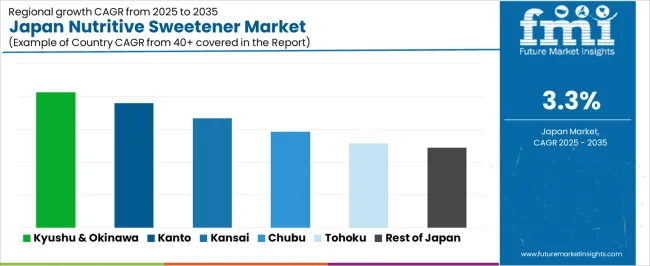
| Region | CAGR (%) |
|---|---|
| Kyushu & Okinawa | 4.1% |
| Kanto | 3.8% |
| Kinki | 3.3% |
| Chubu | 2.9% |
| Tohoku | 2.6% |
| Rest of Japan | 2.4% |
The demand for nutritive sweeteners in Japan is steadily growing, with Kyushu & Okinawa leading at a 4.1% CAGR. This growth is driven by increasing consumer preference for healthier sweetening alternatives in food and beverages. Kanto follows closely at 3.8%, with strong adoption in food manufacturing and e-commerce. Kinki records a 3.3% CAGR, supported by its well-established food industry. Chubu shows a 2.9% CAGR, while Tohoku and the Rest of Japan experience slower growth rates at 2.6% and 2.4%, respectively, due to less dense urbanization and slower adoption of alternative sweeteners.
Kyushu & Okinawa is experiencing the highest demand growth for nutritive sweeteners in Japan, with a 4.1% CAGR. The region’s growing health-conscious population and increasing focus on wellness are major factors driving this trend. As consumers in Kyushu & Okinawa become more health-aware, there is a growing demand for food and beverage products with reduced sugar content. Nutritive sweeteners, which provide sweetness with fewer calories, have become an essential ingredient in meeting these consumer demands.
The region’s rising focus on functional foods and beverages, including low-sugar or sugar-free alternatives, further boosts the adoption of nutritive sweeteners. Additionally, the growing number of health-conscious food manufacturers and retailers in Kyushu & Okinawa is contributing to the widespread use of these sweeteners. As the trend for healthy, low-calorie diets continues to rise, the demand for nutritive sweeteners in Kyushu & Okinawa is expected to remain strong.

Kanto is witnessing strong demand for nutritive sweeteners, with a 3.8% CAGR. This is largely due to the region’s high concentration of food manufacturers and major retail centers, particularly in Tokyo. The region's large urban population is increasingly seeking healthier food and beverage options, which is driving the demand for reduced-calorie sweeteners. As Kanto is Japan’s industrial and commercial hub, the growth in the adoption of nutritive sweeteners is being fueled by the shift toward low-sugar and low-calorie products.
The increased focus on health and wellness in Kanto, especially in large cities, is propelling the demand for functional foods and beverages that cater to the growing consumer preference for natural, low-calorie sweeteners. The region’s food and beverage manufacturers are adopting nutritive sweeteners to meet these changing consumer preferences, ensuring continued growth. With the region’s heavy investment in innovative food solutions and a focus on health trends, the demand for nutritive sweeteners will continue to grow in Kanto.
Kinki, including Osaka and Kyoto, is seeing steady demand for nutritive sweeteners, with a 3.3% CAGR. The region’s well-established food and beverage manufacturing sector plays a significant role in this demand. As the Kinki region continues to modernize its food industry, there is a greater adoption of alternative sweeteners, driven by the demand for healthier and lower-calorie food products. The region’s consumers are becoming more health-conscious, and this has contributed to the rising preference for foods with reduced sugar content.
Kinki’s focus on functional foods, particularly in sectors such as beverages, dairy, and confectionery, is driving the demand for nutritive sweeteners. As manufacturers in the region seek to meet consumer demand for healthier food and beverage options, nutritive sweeteners are being increasingly used in a variety of products. With a continued emphasis on innovation in food production and health trends, Kinki is expected to maintain steady growth in the demand for nutritive sweeteners.
Chubu is experiencing moderate growth in the demand for nutritive sweeteners, with a 2.9% CAGR. The region’s strong industrial base, particularly in food production, is a key driver of this demand. As the food industry in Chubu adapts to consumer preferences for healthier, low-calorie products, there is a growing use of nutritive sweeteners in processed foods and beverages. Additionally, the increasing number of food manufacturers in the region is supporting the steady adoption of these sweeteners.
The region’s emphasis on improving food products and the growing demand for health-conscious offerings are contributing to the rise in the use of nutritive sweeteners. Although growth in Chubu is slower compared to other regions, the steady shift towards lower-sugar alternatives ensures that the demand for nutritive sweeteners will continue to grow at a moderate pace in the region.
Tohoku is experiencing steady but slower growth in the demand for nutritive sweeteners, with a 2.6% CAGR. The region, while more rural compared to other parts of Japan, is gradually adopting healthier food alternatives as awareness of nutrition and wellness increases. As Tohoku’s food production industry continues to modernize, the demand for alternative sweeteners that support healthier lifestyles is growing. Nutritive sweeteners are becoming an important ingredient in the region’s food and beverage sector, particularly in products targeted at health-conscious consumers.
The region’s increasing focus on functional foods and reducing sugar consumption is driving the use of nutritive sweeteners in various food products. Although the adoption is slower compared to urban areas, Tohoku’s gradual embrace of healthier, low-calorie ingredients is contributing to the steady growth in the demand for these sweeteners.
The Rest of Japan, which includes rural and less urbanized regions, is seeing steady growth in the demand for nutritive sweeteners, with a 2.4% CAGR. The demand for healthier food alternatives is gradually spreading to these regions as consumers become more aware of the health benefits of reducing sugar intake. Food manufacturers in the Rest of Japan are beginning to incorporate nutritive sweeteners into their products, particularly in the areas of dairy, snacks, and beverages.
The ongoing focus on health and nutrition in rural areas is contributing to the growing use of low-calorie, sugar-free sweeteners. As the region continues to modernize its food production processes and respond to health-conscious consumer trends, the demand for nutritive sweeteners will continue to rise, although at a slower rate compared to more urbanized areas.
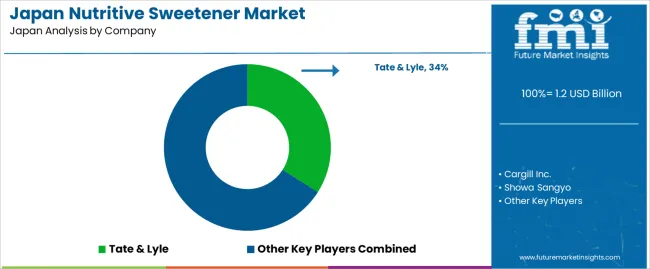
The demand for nutritive sweeteners in Japan is growing steadily as food manufacturers seek to balance traditional taste profiles with evolving health and wellness trends. Nutritive sweeteners those that provide calories and energy remain widely used in formulations for bakery items, confectionery, dairy products, beverages, and snacks. With Japanese consumers increasingly focused on functional foods and ingredient transparency, the need for high-quality nutritive sweeteners that deliver sweetness while supporting texture and mouthfeel is gaining importance.
In the Japanese demand landscape, Tate & Lyle holds a leading share of approximately 34.0%, underscoring its strong position through a broad ingredient portfolio and strong relationships with Japanese food and beverage manufacturers. Other key contributors in the industry include Cargill Inc., Showa Sangyo, Japan Corn Starch Co., and COFCO International, each serving the demand for nutritive sweeteners in Japan’s food processing industry. Their role is vital in supplying ingredients that help manufacturers meet both functional and sweetness requirements.
Key drivers of demand include the sustained consumption of processed and convenience foods, the need for ingredient solutions that maintain product quality during texture reformulation, and the growth in sports nutrition and fortified foods in Japan. Cosmetic factors such as mouthfeel, stability under processing conditions, and compatibility with clean‑label claims also contribute. Despite the rise of low‑calorie and non‑nutritive alternatives, nutritive sweeteners continue to play a vital role in many applications where calorie content is acceptable or desired. The outlook for nutritive sweeteners in Japan remains positive, supported by steady demand in traditional applications and evolving opportunities in functional food development.
| Items | Values |
|---|---|
| Quantitative Units | USD 1.2 Billion |
| Form | Powder, Granule |
| Ingredient Type | Zinc, Sodium, Potassium, Calcium, Phosphorous, Magnesium |
| End Use | Food Industry, Dairy, Bakery & Confectionery, Breakfast Cereals, Meat & Fish, Ready-to-eat Meals |
| Distribution Channel | Store-based Retailing, Indirect Sales, Direct Sales, Hypermarket/Supermarket, Convenience Store, Discount Store |
| Regions Covered | Kyushu & Okinawa, Kanto, Kinki, Chubu, Tohoku, Rest of Japan |
| Key Players Profiled | Tate & Lyle, Cargill Inc., Showa Sangyo, Japan Corn Starch Co., COFCO International |
| Additional Attributes | Dollar sales by form, ingredient type, end-use categories, distribution channels, and regional trends. |
The global demand for nutritive sweetener in japan is estimated to be valued at USD 1.2 billion in 2025.
The market size for the demand for nutritive sweetener in japan is projected to reach USD 1.7 billion by 2035.
The demand for nutritive sweetener in japan is expected to grow at a 3.3% CAGR between 2025 and 2035.
The key product types in demand for nutritive sweetener in japan are fructose, sucrose, corn sugar, honey and high fructose corn syrup.
In terms of nature, organic segment to command 65.0% share in the demand for nutritive sweetener in japan in 2025.






Our Research Products

The "Full Research Suite" delivers actionable market intel, deep dives on markets or technologies, so clients act faster, cut risk, and unlock growth.

The Leaderboard benchmarks and ranks top vendors, classifying them as Established Leaders, Leading Challengers, or Disruptors & Challengers.

Locates where complements amplify value and substitutes erode it, forecasting net impact by horizon

We deliver granular, decision-grade intel: market sizing, 5-year forecasts, pricing, adoption, usage, revenue, and operational KPIs—plus competitor tracking, regulation, and value chains—across 60 countries broadly.

Spot the shifts before they hit your P&L. We track inflection points, adoption curves, pricing moves, and ecosystem plays to show where demand is heading, why it is changing, and what to do next across high-growth markets and disruptive tech

Real-time reads of user behavior. We track shifting priorities, perceptions of today’s and next-gen services, and provider experience, then pace how fast tech moves from trial to adoption, blending buyer, consumer, and channel inputs with social signals (#WhySwitch, #UX).

Partner with our analyst team to build a custom report designed around your business priorities. From analysing market trends to assessing competitors or crafting bespoke datasets, we tailor insights to your needs.
Supplier Intelligence
Discovery & Profiling
Capacity & Footprint
Performance & Risk
Compliance & Governance
Commercial Readiness
Who Supplies Whom
Scorecards & Shortlists
Playbooks & Docs
Category Intelligence
Definition & Scope
Demand & Use Cases
Cost Drivers
Market Structure
Supply Chain Map
Trade & Policy
Operating Norms
Deliverables
Buyer Intelligence
Account Basics
Spend & Scope
Procurement Model
Vendor Requirements
Terms & Policies
Entry Strategy
Pain Points & Triggers
Outputs
Pricing Analysis
Benchmarks
Trends
Should-Cost
Indexation
Landed Cost
Commercial Terms
Deliverables
Brand Analysis
Positioning & Value Prop
Share & Presence
Customer Evidence
Go-to-Market
Digital & Reputation
Compliance & Trust
KPIs & Gaps
Outputs
Full Research Suite comprises of:
Market outlook & trends analysis
Interviews & case studies
Strategic recommendations
Vendor profiles & capabilities analysis
5-year forecasts
8 regions and 60+ country-level data splits
Market segment data splits
12 months of continuous data updates
DELIVERED AS:
PDF EXCEL ONLINE
Demand Signal Repository Solutions Market Size and Share Forecast Outlook 2025 to 2035
Demand Side Management Market Size and Share Forecast Outlook 2025 to 2035
Demand Response Market Analysis - Size, Share, and Forecast Outlook 2025 to 2035
North America Shipping Supplies Market Trends – Innovations & Growth 2024-2034
Demand of Kozani Saffron in Greece Analysis - Size, Share & Forecast 2025 to 2035
Demand of No-acid Whey Strained Dairy Processing Concepts in European Union Size and Share Forecast Outlook 2025 to 2035
Demand for Bronte Pistachio in Italy Analysis - Size, Share & Forecast 2025 to 2035
Demand and Trend Analysis of Gaming Monitor in Western Europe Size and Share Forecast Outlook 2025 to 2035
Demand and Trend Analysis of Gaming Monitor in Korea Size and Share Forecast Outlook 2025 to 2035
Demand and Trend Analysis of Gaming Monitor in Japan Size and Share Forecast Outlook 2025 to 2035
Glycine Soja (Soybean) Seed Extract Market Size and Share Forecast Outlook 2025 to 2035
Demand and Trend Analysis of Yeast in Japan - Size, Share, and Forecast Outlook 2025 to 2035
Demand of Pistachio-based desserts & ingredients in France Analysis - Size, Share & Forecast 2025 to 2035
Western Europe Men’s Skincare Market Analysis – Forecast 2023-2033
Demand and Trends Analysis of Stevia in Japan Size and Share Forecast Outlook 2025 to 2035
Japan Women’s Intimate Care Market Trends – Growth & Forecast 2024-2034
Demand and Trend Analysis of Fabric Stain Remover in Korea Size and Share Forecast Outlook 2025 to 2035
Demand and Sales Analysis of Paper Cup in Korea Size and Share Forecast Outlook 2025 to 2035
Demand and Sales Analysis of Paper Cup in Western Europe Size and Share Forecast Outlook 2025 to 2035
Demand of MFGM-enriched Powders & RTDs in European Union Size and Share Forecast Outlook 2025 to 2035

Thank you!
You will receive an email from our Business Development Manager. Please be sure to check your SPAM/JUNK folder too.
Chat With
MaRIA